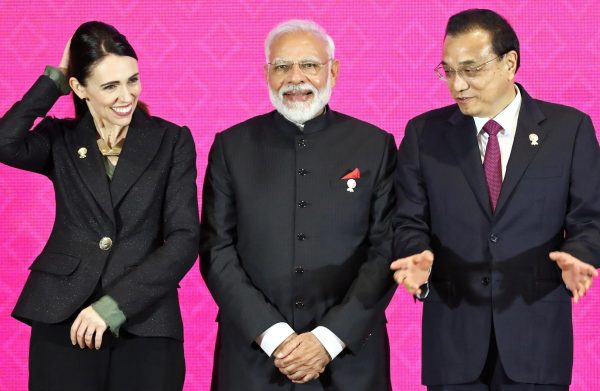Remaining participants, including New Zealand, could each do more to convince India to stay and the door is still open.
The agreement’s 20 chapters are comprehensive in scope and go beyond just the liberalisation of goods and services. Rules around digital trade, movements of people, small and medium-sized enterprise operations, government procurement and intellectual property are being assembled — domains that are rarely covered in other PTAs.
New Zealand has existing bilateral or multilateral PTAs with all other RCEP participants except India, including through the Comprehensive and Progressive Trans-Pacific Partnership (CPTPP) and the ASEAN–Australia–New Zealand Free Trade Agreement (AANZFTA) regional deals. Adding RCEP on top of these initiatives consolidates the combined gains from regional trade by strengthening existing rules and adding new ones, chiefly to the benefit of global value chains — now especially important in the context of the trade war between the region’s two largest economies, the United States and China.
RCEP is an expression of New Zealand’s interest in finally establishing a trade agreement with India, the world’s seventh largest economy by nominal GDP and third largest by purchasing power parity. India is New Zealand’s 13th largest trading partner. According to Statistics New Zealand, the tourism industry dominates New Zealand’s bilateral exports, comprising NZ$900 million (US$596 million), more than half the total value of NZ$1.6 billion (US$1.06 billion). Goods are only 43 per cent of exports at NZ$709 million (US$469 million). Meanwhile, 73 per cent of New Zealand’s imports from India are in goods, amounting to NZ$730 million (US$483 million).
Evaluation of RCEP suggests a strong margin of preference for New Zealand’s goods exports to India, particularly in agriculture. According to the WTO, a simple average of applied tariffs by New Zealand on a 2018 most favoured nation basis is 2 per cent overall (1.4 per cent for agricultural products and 2.1 per cent for non-agricultural products), as compared to around 17 per cent for India (38 per cent for agricultural products and 14 per cent for non-agricultural products). Anxiety over a potential inundation of imports after ratification is a key and undue reason behind India’s unwillingness to consider tariff reductions in agricultural imports, particularly in dairy. But New Zealand’s total dairy production is only 13 per cent that of India’s and unlikely to grow to a level that could flood the vast Indian market with cheaper imports, even considering a phased tariff rated quota over a 10–12 year period.
In making progress towards bringing India back to RCEP, the two countries should strengthen bilateral initiatives alongside the multilateral dialogues and negotiations. This requires that New Zealand along with other RCEP members recognise the strategic significance of keeping India engaged in trade liberalisation. While India does need to undertake domestic reform to better support trade liberalisation initiatives, clearly a concerted effort by the participants to address some of India’s concerns will be required.
In particular, participants might consider stronger rules of origin consistent with the regional not bilateral nature of the RCEP agreement, providing protection against possible import surges, and taking 2019 as the base year for any tariff reduction. Weak commitments towards reducing non-tariff barriers are also a key complaint of India’s. Bilateral progress between New Zealand and India should be made towards finding common points of agreement. This would not be unusual — efforts are already ongoing in review of India’s existing PTAs with ASEAN, Japan and South Korea.
It’s important for New Zealand to also consider promoting partnership and technological collaboration with India in agricultural trade, including dairy, to contribute towards increasing India’s agricultural productivity. India would in turn be more receptive to opening access to its goods market, particularly in the high-quality end of the value chain. The recent joint venture between New Zealand’s Fonterra and India’s Future Group to launch the Dreamery yogurt range serves as an example of potential opportunities.
So too should collaboration between New Zealand and India better focus on ICT, education and tourism services — areas of mutual complementarities for both countries. Substantive partnerships would help overcome critical skill shortages in New Zealand and address constraints in India’s move towards becoming a knowledge-based economy. India’s pharmaceutical and healthcare industries present other opportunities to New Zealand given its rapidly ageing population, with potential to lower healthcare costs and expand research capabilities.
New Zealand could also recognise the importance India places on partners adopting policy that streamlines physical movement, including on-arrival visas, multiple entry long-term business visas and cultural exchanges. Closer people-to-people ties and better involving the 170,000-strong Indian diaspora living in New Zealand — many of them professionals — would spur further investment, currently of insignificant value. But all this requires New Zealand’s policymakers to reassess immigration policy, a deeply politically sensitive issue — just as agricultural tariffs remain a sensitive issue for India.
Despite being a relatively small player, New Zealand remains in a position to encourage India back to RCEP and towards greater economic integration to the benefit of India itself and the broader region.
Rahul Sen is a Senior Lecturer at School of Economics at Auckland University of Technology (AUT). The views expressed here are personal.
Mukul Asher is an independent consultant in public financial management and pension reform based in Singapore.

